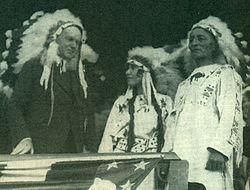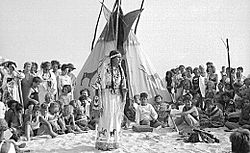Rosebud Yellow Robe facts for kids
Quick facts for kids
Rosebud Yellow Robe
|
|
|---|---|
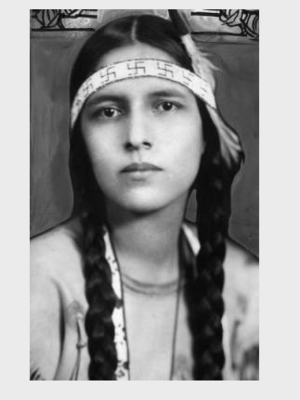
circa 1927
|
|
| Born | 26 February 1907 Rapid City, South Dakota
|
| Died | 5 October 1992 (aged 85) |
| Other names | Lacotawin |
| Known for | Folklorist, educator and author |
| Parent(s) | Chauncey Yellow Robe (father) Lillian Belle Springer (mother) |
| Family | Chauncina and Evelyn (sisters) |
Rosebud Yellow Robe (whose Lakota name was Lacotawin) was born on February 26, 1907, and passed away on October 5, 1992. She was a Native American folklorist, teacher, and writer, with half Lakota Sioux heritage. Rosebud was greatly inspired by her father, Chauncey Yellow Robe. She used storytelling, live performances, and books to teach many generations of children about Native American traditions and stories.
Rosebud became famous to thousands of children who visited the Indian Village at Jones Beach, New York, every summer from 1930 to 1950. From the late 1930s through the 1950s, she was also a well-known voice on radio. She appeared regularly on NBC children's programs from the CBS Broadcast Center in New York City.
Later in her life, Rosebud continued sharing her stories and giving talks at the American Museum of Natural History and the Donnell Library in New York. In 1994, her work as an educator was honored with a special performance called "Rosebud's Song." This event was put on by the National Dance Institute at New York City's Madison Square Garden.
Contents
Rosebud's Early Life and Education
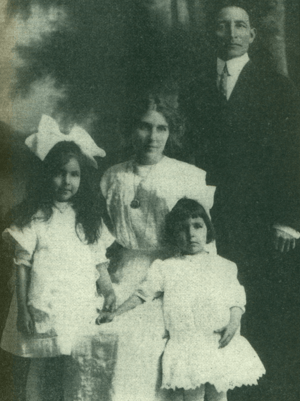
Rosebud Yellow Robe was born on February 26, 1907, in Rapid City, South Dakota. She was the oldest of three daughters born to Chauncey Yellow Robe and Lillian Belle Sprenger. Rosebud was named after the Rosebud Indian Reservation in South Dakota.
Her father, Chauncey Yellow Robe, was a famous educator, speaker, and Native American activist. In 1905, he married Lillian Belle Sprenger, who had Swiss-German roots. Lillian was a volunteer nurse at the Rapid City Indian School. This school was for Native American children from the Northern Plains, including the Sioux and Northern Cheyenne tribes.
Learning from Her Parents
Rosebud's parents' marriage helped her learn to connect different cultures. Her father, Chauncey, taught Rosebud and her sisters, Chauncina and Evelyn, about Lakota traditions. Sometimes, older Native Americans would visit the Indian School and tell stories in the Lakota language. Chauncey would have Rosebud listen, even if she didn't understand the words. Later, he would retell the stories in English.
Chauncey chose to send his daughters to public schools for their regular studies. He spent many hours telling his children the tales he had learned from his own grandparents. Rosebud also enjoyed the Indian School's library and programs.
Rosebud Yellow Robe was one of the first Native American students at the University of South Dakota in Vermillion, South Dakota. She attended the university from 1925 to 1927. During this time, she took part in shows and presentations about Native American dances. In 1927, her mother, Lillie, passed away. This led Rosebud to take on the care of her two younger sisters.
Meeting President Calvin Coolidge
On August 4, 1927, U.S. President Calvin Coolidge and his wife visited the Black Hills of South Dakota. During this visit, President Coolidge was made an honorary member of the Sioux tribe. This was to thank him for supporting the Indian Citizenship Act of 1924. This act gave all American Indians full U.S. citizenship.
The ceremony was led by Chief Chauncey Yellow Robe and Rosebud. Chauncey gave President Coolidge the name "Leading Eagle." Rosebud then placed a handmade Lakota warbonnet on the President's head. At this time, Rosebud was a student at the University of South Dakota.
Rosebud Becomes Famous
News reporters shared Rosebud's image widely, and she quickly became a national celebrity. The press often talked about her "grace and beauty." After this event, film and theater agents wanted her to join their projects. In 1928, famous director Cecil B. DeMille even tried to get her to play the main role in his movie, Ramona. However, Rosebud said no. Her friends said she looked a lot like the silent movie star Dolores del Río, who eventually played the part.
Life in New York City
After becoming famous from the President Coolidge event, Rosebud Yellow Robe moved to New York City at age 20. She wanted to start a career in theater. Rosebud created a dance act and performed in Native American costumes in theaters and hotels. She was very popular, and many people recognized her from the news.
Her father, Chauncey Yellow Robe, had a big influence on her. Rosebud disliked how Native Americans were shown incorrectly in radio shows and silent films. She believed that most non-Native people didn't understand what Native Americans could achieve. So, she used storytelling, performances, and books to teach children about Native American traditions and culture. Rosebud lived in New York for 65 years.
Her Family Life
In 1927, Rosebud met newspaper reporter Arthur Seymour. They fell in love, married in 1929, and settled in New York City. That same year, they had a daughter named Tahcawin de Cinq-Mars Moy, also called "Buddy" or "Taki." She was named after Rosebud's grandmother. Arthur also helped raise Rosebud's younger sister, Evelyn. He acted as Rosebud's publicist, arranging her talks about Lakota culture at places like the American Museum of Natural History. Arthur Seymour passed away in 1949.
The Indian Village at Jones Beach
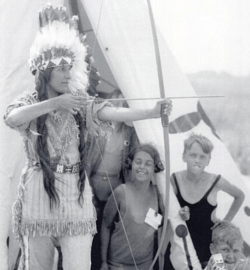
In 1930, park planner Robert Moses hired Rosebud Yellow Robe to be the Director of the Indian Village at Jones Beach State Park. She became a well-known figure to thousands of children who visited the village every summer from 1930 to 1950.
The Indian Village at Jones Beach was designed to look like a Plains Indian village for children. It had three large tipis. The main Council Tipi held museum displays with items borrowed from the American Museum of Natural History. The other tipis were used as clubhouses for the children.
Rosebud taught tens of thousands of schoolchildren and many generations of New Yorkers about Native American history and culture. She mostly told stories and legends from the Lakota and local Eastern Woodlands tribes. Rosebud remembered that when she first spoke to classes in New York, "many of the smaller children hid under their desks." This was because they had seen movies that showed Native Americans as scary.
Rosebud dressed in a 19th-century Lakota Indian costume. This included a deerskin dress, leggings, moccasins, and a feathered warbonnet, which women usually did not wear. Children listened to stories and legends that Rosebud and her sisters had heard from their father. She taught them about Native American culture through crafts, games, and songs. Each year, the village held an American Indian Art Exhibit. Children's projects were shown and judged, and winners received real Native American items.
During the winter, Rosebud visited schools and libraries, dressed in her tribal costume, to share Lakota stories and legends. In the summer of 1932, she organized a "Peace Council Fire" ceremony. About 1,000 people attended, including 300 children.
Rosebud and Citizen Kane
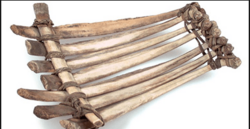
In the late 1930s, Rosebud Yellow Robe and Orson Welles both worked at the CBS Broadcast Center in New York. They were both famous on different radio shows. Some people believe Welles might have used Rosebud Yellow Robe's name for his famous film Citizen Kane (1941). In the movie, the main character's last word is "Rosebud."
Film experts have called the origin of the name "Rosebud" the biggest secret in cinema. The movie made a childhood sled a famous symbol. In 1991, a reporter named Edward Castle suggested that Rosebud Yellow Robe's name inspired Welles. He found daily sign-in sheets for CBS Radio. Both Welles and Rosebud signed these logs on the same days. They might not have known each other, but they would have seen each other at the studio.
In 1961, Rosebud Yellow Robe and her husband, Alfred A. Franz, gave a late 19th-century Lakota sled to the National Museum of the American Indian. This sled was made from eight buffalo ribs. It is believed to have been the childhood sled of Rosebud's father, Chauncey. Orson Welles, who died in 1985, never said where he got the name "Rosebud" from. Rosebud Yellow Robe, when asked if she was named after the sled, would always reply, "Why no, the sled was named after me!"
Later Life and Work
In 1951, Rosebud married photographer and publicist Alfred A. Frantz. He also supported her goals. Frantz was born in 1908 and grew up in Sioux Falls, South Dakota. He also attended the University of South Dakota, though he and Rosebud never met there. He moved to New York City in the 1930s. In 1938, Frantz hired Rosebud to greet young Americans at the piers for a Norwegian ship. Frantz continued to write until he passed away in 1993.
Working in Television and Film
In the 1950s, Rosebud Yellow Robe appeared regularly on NBC children's TV programs. She was also featured on Robert Montgomery Presents. In 1950, Twentieth-Century Fox hired Rosebud to promote their movie Broken Arrow across the country.
This movie was directed by Delmer Daves and starred James Stewart. Broken Arrow was nominated for three Academy Awards. It also won a Golden Globe award for Best Film Promoting International Understanding. Film historians say it was one of the first major Western movies after World War II to show Native Americans in a positive way.
During her publicity tour, Rosebud was interviewed by newspapers. She explained that there was no such thing as "Indian princesses." She said this idea started when Pocahontas went to England and the English called her "Lady Rebecca." Americans then decided she must be royalty, so they made her a "princess." Rosebud also complained about how Native Americans were shown on radio, TV, and in movies. She worried that a new generation of children were learning old, untrue ideas about "whooping, warring Indians."
Authoring Children's Books
Rosebud Yellow Robe wrote two children's books. Her first book, An Album of the American Indian, was published in 1969. It explores centuries of Native American history. It shows the daily lives of seven different Native American tribes before Europeans arrived.
Her second book, Tonweya and the Eagles, and other Lakota Indian Tales, came out in 1979. This book contains real Native American folk tales for children. These stories were based on the tales from her own childhood, taught to her by her father. The stories feature a young boy named Chano, which is short for Canowicakte, her father's Lakota name. Rosebud's work was recognized on the Texas Bluebonnet Award Master List in 1981. It also won awards at the American Indian Art Exhibit in Scottsdale, Arizona.
Honors and Legacy
In her later years, Rosebud continued her storytelling and lectures at the American Museum of Natural History and the Donnell Library in New York. In 1984, the W.H. Over Museum in Vermillion, South Dakota, ordered a life-sized oil painting of Rosebud Yellow Robe. In May 1989, the University of South Dakota held a three-day celebration called "Rosebud Yellow Robe Day." Rosebud received an honorary doctorate degree. This honored her work in connecting cultures and helping people better understand Native Americans.
Rosebud Yellow Robe passed away from cancer on October 5, 1992, at the age of 85.
In 1994, her work as an educator was honored with a performance called "Rosebud's Song" by the National Dance Institute at New York City's Madison Square Garden. This event included a dance set to music by folk singer Judy Collins. A chorus of 1,000 children from around the world also performed. The performance was dedicated to Rosebud Yellow Robe for "devoting her life to children and to preserving and passing on Native American stories and culture." Also in 1994, the University of South Dakota created the "Rosebud Yellow Robe Society" and the "Rosebud Yellow Robe Scholarship" to continue her legacy.


